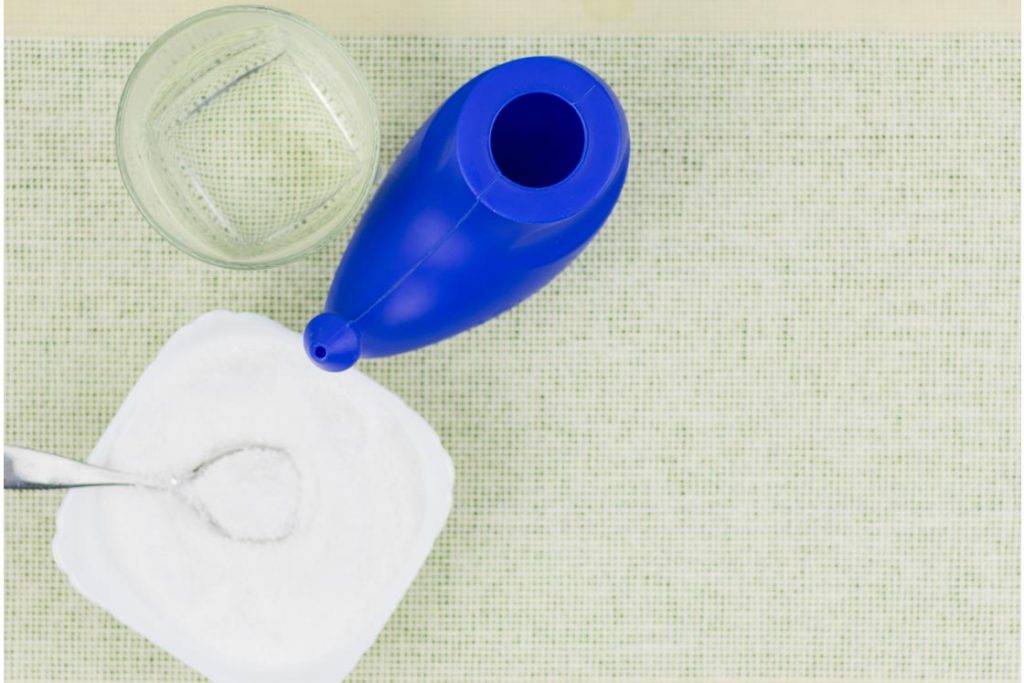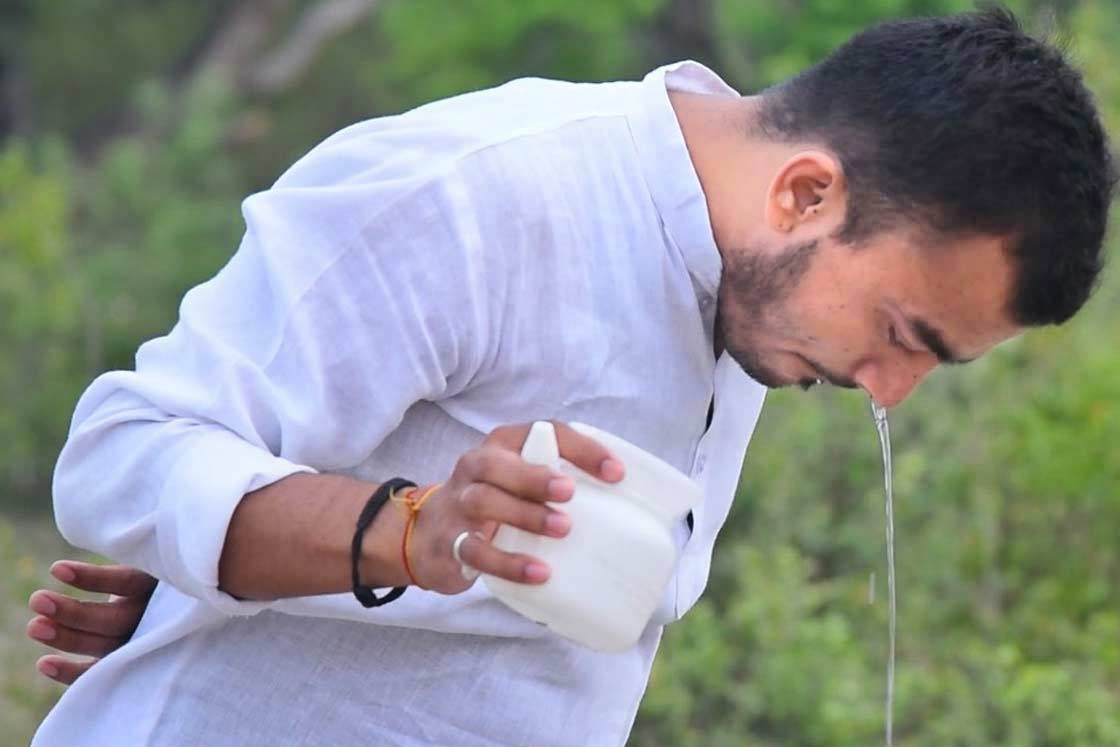
In a yogic lifestyle, much importance is given to the process of cleansing. Deep cleansing of all our organs is considered essential to let the impurities, infections out and clear our system for the intake of the goodness of yoga.
These cleansing techniques of yoga are called the Kriyas. They form an important section called the Shatkarmas in the Hatha Yoga Pradipika, a classical treatise of Hatha Yoga.
In this article, we will explain the procedure of Jal Neti, one of the popular kriyas of yoga for nasal cleansing.
What is Jal Neti?
Jal Neti is one of the purification kriyas of yoga which is dedicated to the cleansing of the nasal passage. There are other types of neti as well which is used for nasal cleansing.
The term Jal Neti literally translated as “water cleansing”, also called Nasal Irrigation. In this kriya, water is used to clear out the nasal congestion so that a person can breathe healthily.
Also, improper or unhealthy condition of the nasal passage is associated with many other diseases such as migraine, sinus, and respiratory dysfunctions like asthma. Jala Neti relieves all these troubles by purifying the nasal passage.
Besides draining out all the impurities clogging your nasal passage, jal neti is helpful for clairvoyance and effectively do pranayama practice. Doing this kriya is useful for you if you reside in a place affected by Air Pollution or is congested.
When the nose is free from any blockages or discomfort, you can better benefit from pranayamas. Thus, the process of Jal Neti is periodically done to clean the sinuses and maintain nasal hygiene.
Benefits of Jal Neti
The process of Jal Neti offers multifold benefits. It is considered a therapeutic process that maintains the health of the nasal passage so that a person can breathe better and avoid any nasal trouble.
Some of the important benefits of Jal Neti are as follows;
1. It Treats the Sinusitis
A very large population, including children, suffer from sinusitis. Doing Jal Neti frequently has been found beneficial for treating the symptoms of sinusitis. It rinses away the irritants and allergies to clear the nasal path and relieves sinusitis.
In an experiment conducted on patients with Chronic Rhinosinusitis, jala neti reduced the symptoms like the need to blow the nose, running nose, postnasal discharge, and sneezing to a great extent [efn_note] Effect Of Saline Nasal Irrigation (Jala Neti) In Chronic Rhino Sinusitis http://www.ijiras.com/2018/Vol_5-Issue_7/paper_54.pdf [/efn_note].
In another review study Health and Therapeutic Benefits of Shatkarma [efn_note] Health and therapeutic benefits of Shatkarma: A narrative review of scientific studies https://www.sciencedirect.com/science/article/pii/S0975947620301297 [/efn_note], it is found that after a period of regular Jal Neti practice, the symptoms and the need for external medication were significantly reduced. Nasal cleansing, neti was particularly found beneficial in managing rhinosinusitis in age groups ranging from children to adults.
2. It Helps Breathe Freely
Jal Neti is responsible for throwing away all the infections and unhealthy particles out of the nasal passage. And as a result, one is able to breathe naturally and freely.
In research, it was demonstrated that Jal Neti helps dissolve the internal build-up of mucus and clears the nasal cavity, making the breath deep and effortless.
Performing Jal Neti regularly acts as a fighting mechanism against various nasal as well as upper respiratory infections.
3. It Treats Headache and Hypertension
Doing Jal Neti lessens the excessive heat and thus offers cooling and soothing benefits to the brain.
It helps cure headaches, hypertension, migraine, and other brain-related disorders. Jal Neti has also been found to be effective in the treatment of epilepsy, temper tantrums, hysteria, depression, and overall mental tension.
4. It Helps Improve the Nasal Functions
The nose is the centre of the danger triangle of the face, as considered by Western medicine. Any infection that occurs in the area around the nose, can be a dreadful situation as respiration is also connected to this passage.
Jal Neti works on the areas around the nose and removes all the impurities over there. It results in improved nasal functions and increased nasal as well as respiratory health.
5. It Improves the Vision
The Jal Neti also has positive effects on the optic nerve. In a 2010 study [efn_note] Effects of Jala Neti on Optic Nerve Conduction Velocity https://www.researchgate.net/profile/Kamakhya-Kumar/publication/215447507_Effect_of_Jala_Neti_on_Optic_Nerve [/efn_note] it was demonstrated that Jal neti can improve optic nerve conduction.
It means that Jal Neti cleans the fused matter of the ENT system as well as the eye and its post retinal optic nerves.
The optic nerves get stimulated through the charging of the autonomic nervous system and improve optic nerve functioning, resulting in clearer vision
6. It Treats Major ENT Diseases
Jal Neti has proven effective on not just nasal troubles but also the diseases related to ears and throat.
In 2018, when the Immediate Effects of Jal Neti were observed by the Yoga and Naturopathy Medical College Chennai [efn_note] Immediate effect of Jala Neti (Nasal Irrigation) on nasal peak inspiratory flow on healthy volunteers http://repository-tnmgrmu.ac.in/10176/ [/efn_note], it was found that the Jal Neti maintains healthy secretory and drainage mechanisms of the entire ear, nose, and throat area.
The study also found that Jala Neti helps remove colds and coughs, allergic rhinitis, hay fever, and tonsillitis.
7. It Stimulates the Olfactory Nerves
Total cleansing and purification of the nasal passage are done by Jal Neti and hence it is observed to improve the function of our olfactory nerves.
Neti helps restore the lost sense of smell, thereby also benefiting the relationship between smell, taste, and digestive processes.
Procedure of Jal Neti

Jal Neti is a practice that requires a few preparations before you start with it.
You need a neti pot, a pinch of salt, and lukewarm water as essential things for jal neti.
Here’s the step-by-step procedure;
1. Take a mug of lukewarm water
Water is the medium through which cleansing takes place in jal Neti. Use pure drinking or distilled water to ensure the proper cleansing and avoid any impurity accumulation of water in the nasal cavity.
Further, this water is warmed up at room temperature because nasal muscles absorbance for warm water is usually less than cold water. In this way, no water gets accumulated in the nasal passages.
Check the suitability of water temperature for neti by pouring a little drop on your hand. In this way, you will get an idea of whether the water temperature is suitable to pour into the nose.
Ideally, water should have a temperature equal to what your tears have.
2. Mix salt into it
Using salt in jal neti water further makes the whole solution (saline water) less absorbent for nasal cavity muscles. Ideally, salt used for jala neti is finer ‘sea salt’ as it has no other minerals and quickly dissolves in the water.
If ‘sea salt’ is not available, one can use simple cocking salt for Jala neti as it’s originally occupied from the sea salt.
The solution needs to be made isotonic i.e. similar to the tonicity of human blood.
To make your own saline mixture for Jala neti at home;
- Take 1 pint (16 ounces or around 500 ml) of lukewarm water
- Generally, a solution consists of salinity 1 teaspoon/500 ml is considered ideal for the nose (you can go with 1/2 or even 1/4 teaspoon of salt)
- Mix salt properly in water and then pour it into the neti pot.
3. Pour saline water into neti pot
Neti pot is an instrument similar to a teapot, usually small with a long spout on one side. It’s designed in such a way that it fits easily in the nostrils without any obstructions.
Once the saline solution is mixed well, it’s poured into the neti pot to follow jala neti procedure. Usually, neti pot comes with a capacity of 500 ml (around 1 pint), so this amount of water is enough to clear nasal passages.
Using a Neti pot is simple, place the long spout on one side to insert it in each nostril one by one.
How to Do Jal Neti?

- Add a half teaspoon of salt into the Neti pot filled with sterile lukewarm water.
- Stand with your legs apart and hold the pot in your right hand.
- Now by slightly tilting your head towards the left, insert the nozzle of the Neti pot in your right nostril.
- Start pouring water in the right nostril slowly by breathing normally through your mouth.
- Allow the flow till the Neti pot is empty.
- Repeat the same procedure from your left nostril.
Tip:
- In the whole process of using the neti pot, open your mouth to breath gently through it. Avoid nasal breathing throughout the whole process of using the neti pot.
- If you are not doing jala neti on the sink, Use a container on ground to ‘not spread’ the water draining out of the nose.
After finishing with both the nostrils, remember to clear the remaining water particles by active exhalation through alternate nostrils as in Kapalabhati.
If you are still left with mucus and a blocked nose, you can repeat the whole procedure again.
Drying of the nostrils
After draining the water from both nostrils, the proper drying of the nose is necessary to prevent cold, infection in the sinus or Eustachian tubes of the ear. It may also result in a mild headache if the nose doesn’t get dried up.
- Stand upright and bend forwards from the waist
- Keep your head upside down with the nose pointing towards the floor, In this way, any leftover water is drained from the nose
- Point the nose towards the knees.
- For about 10 times, inhale from the mouth and exhale from the nose in each position.
- The water residues may run down.
- Stand up and breath rapidly through the nostrils for about 10 consecutive breathes. Sniff in and out.
- Focus on the exhalation.
- Use one finger to close off the right nostril and breathe through the left and vice versa.
- Breathe through both the nostrils for 10 times.
Repeat until the nose gets properly dried.
3 Stages of Jala Neti
The practice of Jala Neti comprises 3 stages according to the practitioner level. These 3 stages of Jala Neti are following.
Stage 1 – Simple Jala Neti
It’s the simplest, most practised and beginner stage of Jala neti. In this, Water flows from one nostril to the other (what we have discussed in the above procedure).
Stage 2 – Vyutkarma Kapalbhati
This is an advanced stage of Simple Jala Neti which may require proper guidance from a teacher for the beginners.
It is known as “Sinus Bellowing” or “Vyutkarma Kapalbhati” and works more effectively on the posterior sinuses, whereas simple Jala Neti doesn’t provide many effects.
1. Allow the free flow of water from one nostril to the other (Like simple Jala Neti).
2. While the flow of water through the nostrils, gently sniff it backwards.
3. Spat that water out from the mouth.
4. Avoid swallowing any water.
In another part of this phase, separate inhalation of water from each of the nostrils is done followed by spatting from the mouth. And then the nose is allowed to get dried.
Stage 3 – Sheetkarma Kapalbhati

The Sheetkarma Kapalbhati is the third phase and a more advanced level of simple Jala Neti. It is difficult and can be uncomfortable to perform in the beginning.
In this, water is taken from the mouth and blown out through the nose. It is more beneficial and effective.
When to Practice Jal Neti?
You can do Jal Neti 3 or 4 times a week in the morning empty stomach. However one can daily practice it in the beginning just for the sake of learning, but later as one gets easy with it, should be limited to a few days in a week.
Some practitioners also grease the nostrils with cow ghee (butter) the night before practising. It smoothens the flow of water from the nostrils and helps pass water without disruptions.
People who have a tendency for constant cough and cold can practice Jal Neti daily to reduce the symptoms and get the highest benefits.
Precautions and contraindications
Jal Neti should be avoided if the practitioner has undergone a recent ear or nose surgery. It is not advised to practice Jal Neti if a person has a bleeding nose due to any nasal difficulty.
Moreover, when doing it the very first time, jal neti should be done only under the guidance of an expert yoga teacher.
Practitioners should always ensure that their nostrils are completely dry after practising Jal Neti. If any water droplets remain in the nasal passage, they can cause headaches.
People who have high blood pressure should be careful while drying their noses. If the drying process is done forcefully, there is a chance they feel dizzy.
1. If water runs onto the face

There can be some faults in the pot or its positioning which can cause water to run onto the face while doing jal neti. Performing steps slowly and with caution is a way to prevent water this problem.
Maintaining the right angle between the pot and the head is also helpful in preventing it.
2. If water goes to the back of the throat
It often occurs due to nervousness and hurry. To avoid this, perform the steps slowly, gently with a proper tilt of the head. Take care of the position of the pot.
3. Avoid blockage of water
If water doesn’t flow out, check the end of the nose cone for any obstacles and align it straight. Now tilt the neti pot again and avoid leakage.
4. Nasal irritation
Pollutants present in the water and the contaminated pot cause stinging in the nose. Rinse the pot properly.
To prevent excessive nasal irritation, use pure water and the appropriate proportion of salt.
5. Popping in the ears
The release of pressure from the Eustachian tube during the flow of water inside the nostrils can lead to discomfort in the ears. There is no need to be frightened. It subsides soon.
What are the Side-Effects of Jal Neti?
Itchiness or sneezing are common results of performing a Jal Neti. However, they lessen as you progress in the practice or once the practice becomes familiar to you.
A burning sensation is observed immediately after practising Neti. It can occur if the water in the pot is too hot or if the solution is not right.
Some practitioners also complain of a slight nosebleed as a result of Jal Neti. It can happen if the excessive temperature of the water in the Neti pot. A nosebleed can also occur if a person already has a tendency for it.
To avoid these side effects, Jal Neti is a suggested practice initially under supervision.
Final Thoughts
Cleansing techniques like Jal Neti have been prescribed and practiced as therapeutic processes for a very long time. Hatha Yoga Pradeepika mentions them as purificatory actions to rinse away the unnecessary and prepare our system for the necessary.
However, the karmas discussed by Hatha Yoga require a series of protocols to follow. The techniques are better practiced with a trained supervisor. And once learnt, you can practice them on your own and witness a great number of benefits.
So, if you are going to start preparing for the cleansing practices, go through what is necessary and what is important. Be informed about its all aspects. If you wish to start the right thing, start it the right way!





suggested when pregnant?
can this lead to loss of smell for a particular time period after the neti
Dhanyawaad, this was useful! One question though – for drying nose after Jalneti, can we do Kapaalbhati instead of procedure you talked about?
However, Kapalbhati isn’t required if the purpose is drying up the nose because residue water droplets can enter in during kapalbhati. So it’s better to dry nose with procedure described in the post.